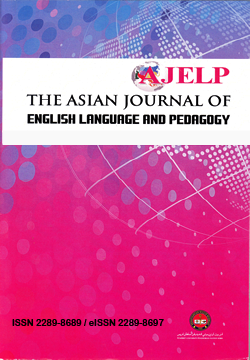English Language Learners’ Readiness towards Mobile Assisted Language Learning
DOI:
https://doi.org/10.37134/ajelp.vol11.1.10.2023Keywords:
English language, mobile language learning, Technology Readiness Index, students’ readiness, tertiary institutionsAbstract
Learning a second language (i.e. English) with the use of mobile technology has been widely accepted around the world. While there are numbers of research focusing on its effectiveness, students’ readiness in accepting the learning approach is yet to be studied. This research aims to investigate the level of readiness among students towards learning the English language via mobile. An adapted version of Parasuraman’s Technology Readiness Index (TRI) questionnaires was employed as the research instrument. A total of 180 respondents from a public university in Malaysia was involved in the study. The research found that the students projected a moderate level of readiness. This is as they are highly optimistic and innovative towards mobile learning but also have a high level of discomfort and insecurities towards it. It is suggested for further research to be carried out to identify the factors influencing students’ readiness and widen the sample by including other tertiary institutions.
Downloads
References
Alkhalifah, T., de Vries, D., & Rampersad, G. (2017). Mobile Learning Adoption in Developing Countries. Proceedings of the 2017 9th International Conference on Education Technology and Computers - ICETC 2017.
Amal, M. (2016). Students' perspective towards Intensive English Course. Linguistic Commons, 276-283.
Attaran, M., & Zainuddin, Z. (2018). How students experience blended learning? Malaysian Experience. Interdisciplinary Journal of Virtual Learning in Medical Sciences.
Babakus, E. M. (1992). Adapting the SERVQUAL scale to hospital services: an empirical investigation. Health Service Research, 767-786.
Elaish, M. M., Shuib, L., Yadegaridehkordi, E., & Alaa, M. (2017). Mobile Learning for English Language Acquisition:Taxonomy, Challenges, and Recommendations. IEEE Access, 19033-19047.
Groves, R. M., Fowler, F. J., & Couper, M. P. (2004). Survey Methodology. Hoboken: John Wiley & Sons.
Heick, T. (2018, August 12). The Definition Of Mobile Learning. Retrieved from teachthought: https://www.teachthought.com/the-future-of-learning/a-definition-for-mobile-learning/
Ismail, I., Bokhare, S., & Azman, N. (2013). Teaching via Mobile Phone: A Case Study on Malaysian Teachers' Technology Acceptance and Readiness. Journal of Educators Online, 38-76.
Kale, U., & Goh, D. (2012). Teaching style, ICT experience and teachers’ attitudes toward teaching with Web 2.0. Education and Information Technologies, 1-20.
Khan, A. I., Al-Shihi, H., Al-khanjari, Z. A., & Sarrab, M. (2015). Mobile Learning (M-Learning) adoption in the Middle East: Lessons learned from the educationally advanced countries. Telematics and Informatics, 32(4), 909–920.
Kintu, M. J., Zhu, C., & Kagambe, E. (2017). Blended learning effectiveness: the relationship between student characteristics, design features and outcomes. International Journal of Educational Technology in Higher Education.
Kukulska, & Traxler. (2016). Rethinking Pedagogy for the Digital Age. London: Routledge.
Ministry of Education, M. (2013). Malaysia Education Blueprint. Putrajaya: Ministry of Education, Malaysia.
Mohammad, S., & Job, M. A. (2014). Adaption of M-Learning as a Tool in Blended Learning- A Case Study inAOU Bahrain. International Journal of Science and Technology, 14-20.
Parasuraman. (2000). Technology Readiness Index (TRI) a multiple-item scale to measure readiness to embrace new technologies. Journal of Service Research, 307-320.
Paul, V. W. (2007). Qualitative Research Methods for Professionals. Boston: Pearson.
Ranjit, K. (2014). Research Methodology: A step-by-step guide for beginners. London, United Kingdom: Sage Publications Ltd.
Sekaran, U. (2003). Research Method for business (4th Ed). Hoboken, New Jersey: John Wiley & Sons.
Shuib, M., Azizan, S. N., & Ganapathy, M. (2018). Mobile Learning Readiness among English Language Learners in Public University in Malaysia. Social Sciences and Humanities Pertanika, 1491-1504.
Traxler, J. (2007). Defining, Discussing and Evaluating Mobile Learning: The moving finger writes and having writ . . . . The International Review of Research in Open and Distributed Learning, 8(2).
Waddell, J. (2015, March 27). The Role of Technology in the Educational Process. Retrieved from College of Education: https://edwp.educ.msu.edu/green-and-write/2015/the-role-of-technology-in-the-educational-process/
Downloads
Published
How to Cite
Issue
Section
License
Copyright (c) 2023 Muhammad Hilmi Che Ahamad, Noraini Zulkepli, Hooi Syn Tan

This work is licensed under a Creative Commons Attribution-NonCommercial-ShareAlike 4.0 International License.





